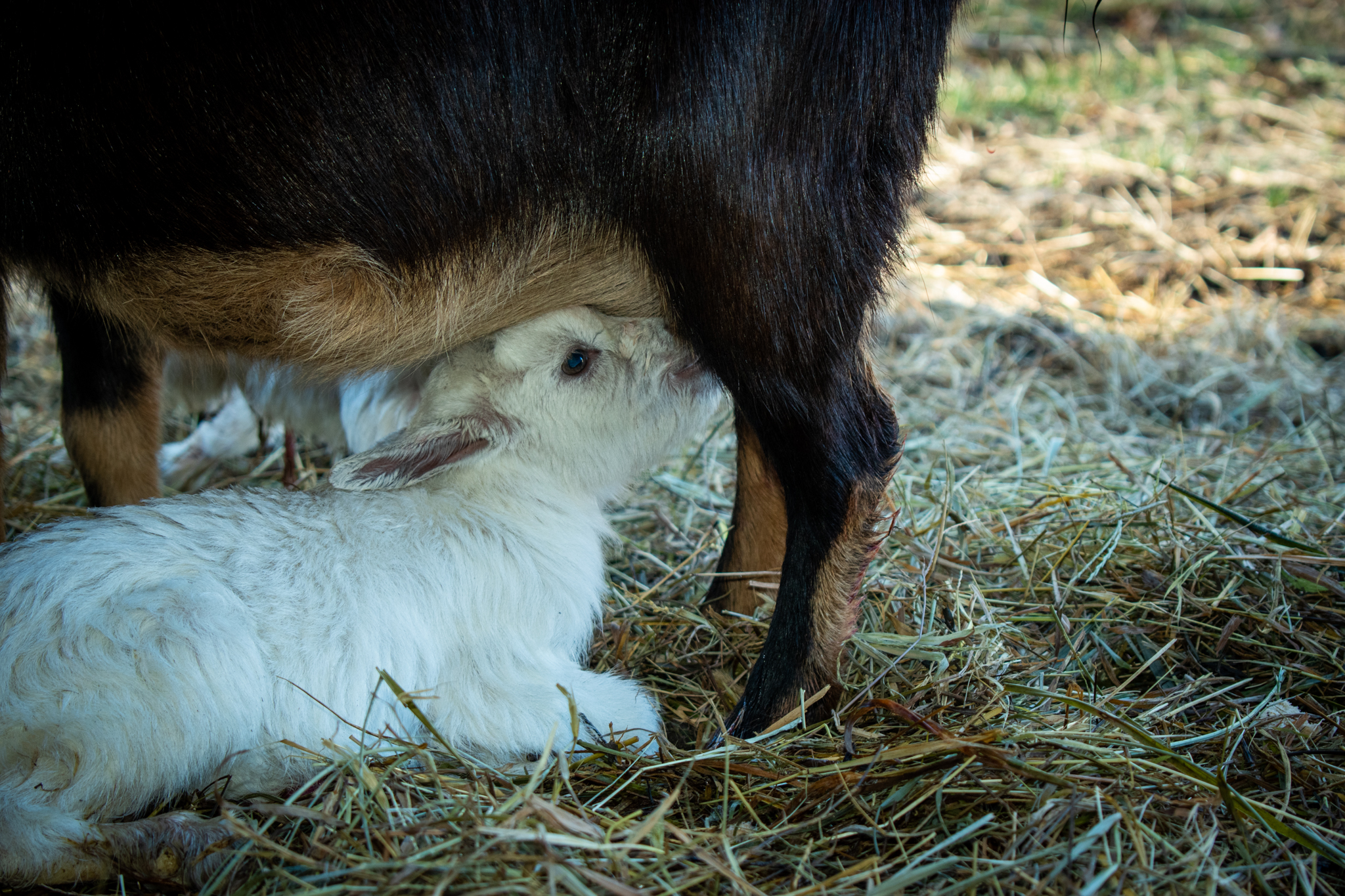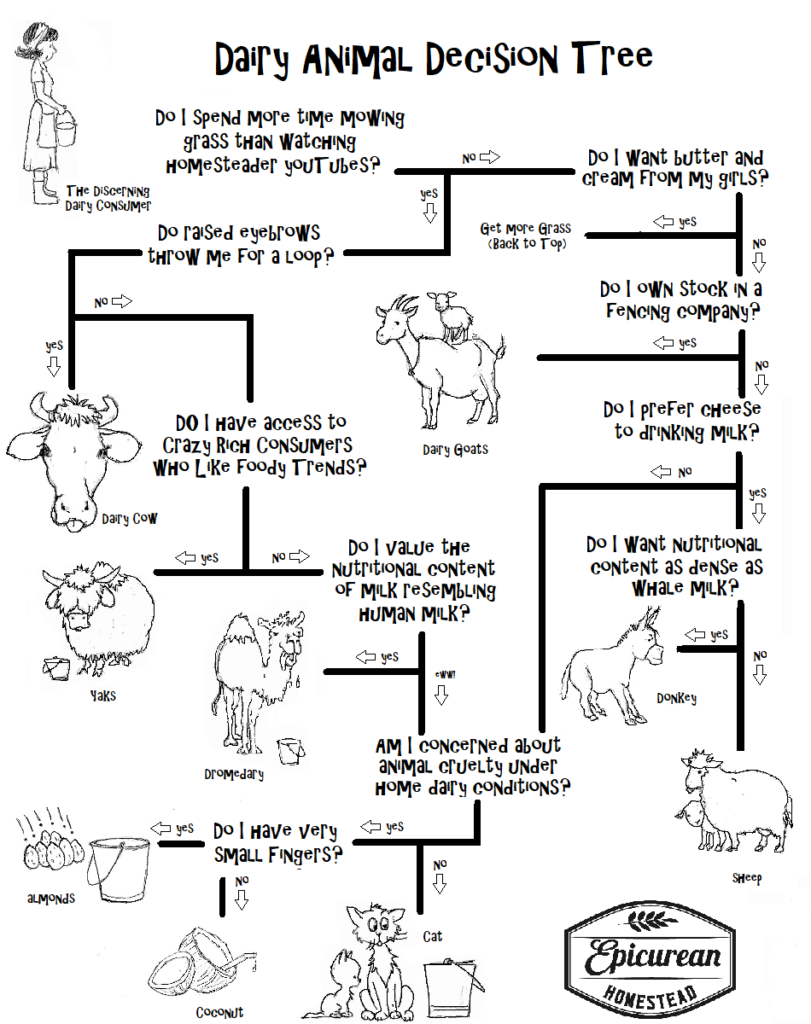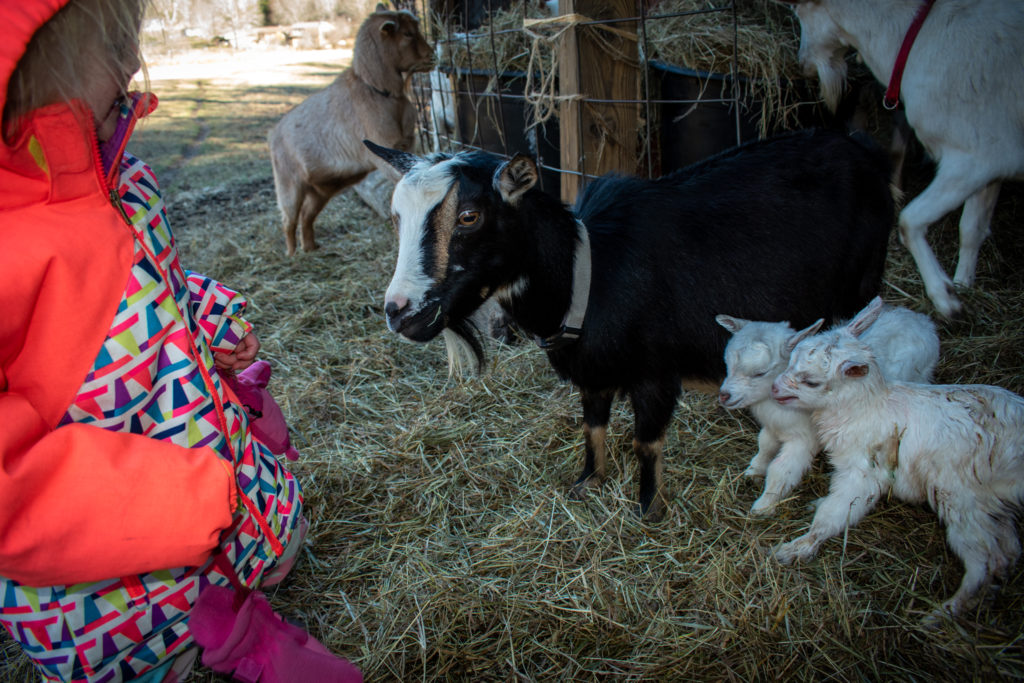What Dairy Species Do I Need?

This article gives an overview of some of the major characteristics of different dairy animals and the major considerations in keeping the species. This top-level overview should help you choose which direction you might want to move in your home dairy production.

BOOM! And done.
Standard Dairy Cow

Milk Basics
Nothing beats a good dairy cow for producing quantities of fresh milk that will run a small homestead and provide all the dairy needs of most families with plenty of by-products to cut feed cost of other species like chickens or pigs. Raw milk, properly handled from a healthy cow, is a nutrition power house like few others and will soon spoil your enjoyment of all commercial milk. Milk from a cow separates easily and naturally into cream and milk with a cream layer forming on the top of the milk which can be skimmed to use as cream, beaten into butter or used in a myriad of other fashions (sour cream, cream cheese, etc.).
Cow milk is made up of water, milk fats, proteins (primarily casein, this is the trigger for those who suffer from milk allergies and occurs in many forms in milk, some possibly more harmful than others), and lactose (a milk sugar and the primary source of ready energy in milk). Human milk is higher in lactose than cows milk and is water-soluble, meaning it is contained primarily in the whey portion of milk and therefore isn’t strongly present in hard cheeses where the whey has been removed. Intolerance to lactose is caused by insufficient lactase activity in the small intestine. This causes the lactose to ferment in the GI tract which can lead to a wide range of symptoms. Cultured milk products usually contain bacteria which produce lactase and partially pre-digest the lactose making these foods easier for people who may suffer from lactose intolerance to digest.
Different species of cows produce different ratios of milk fat to other components and the production of fat also varies during the course of a single lactation based on feed as well as other factors.
What is A1/A2 Milk?
The primary milk protein in cow’s milk is casein. It occurs in many different forms and the different forms break down into different by-products during digestion. Those forms of casein labeled as A1 have been shown to break down into greater quantities of a peptide called BCM-7, which has been associated in some studies with increased incidents of autism, infant diabetes and even SIDS. The studies are not conclusive and don’t seem to trigger adverse reactions in all consumers. Commercial milk has A1 and A2 casein present. Milk from a cow that has been tested A2/A2 – a cost-effective and rapid genetic test often using samples from a cow’s hair follicles – produces only A2 casein in milk which doesn’t break down into the same quantities of BCM-7 during the digestion process. Some breeds such as Jerseys and Guernseys are statistically more likely to be A2/A2 than other breeds.
Freshening
Keeping a bull on hand for freshening (getting pregnant) a single milk cow is often not cost-effective. They are usually dangerous and require a separate containment area, special handling and consume as much feed and forage as your milk cow for the once-a-year use.
Artificial Insemination is widely available in most areas, though you should certainly check into this prior to making your final decision about your dairy species. This process requires a certain degree of expertise as well as costly equipment and DIY AI probably isn’t a good solution for most home dairy producers. The range of semen available from an AI technician and the likelihood that they can effectively settle your girl in one or two visits usually means this is the best route. Sex selected semen is often available.
Forage / Fencing / Shelter
The quantity of forage consumed per gallon of milk produced varies by breed but until you can put in a grazing management system that optimizes the forage available on your lot, you should assume that you will be supplementing hay for much of the year. Our five quite good grazing acres don’t support our two cows and various other ruminants and we buy at least 400 bales of hay each year to supplement the offseason.
Most milk cows are easily contained by a few strands of wire especially when a hot electric wire is run on the inside top of the fence to discourage pushing against them. Those portions of our back pasture which are still only strung in barb wire do nothing to contain the sheep and goats but very easily keep in the cows if fallen trees are kept off them.
The shelter needs of dairy cows vary widely by breed and you’ll want to select based on your climate and lay of your land. Hardy breeds (milking shorthorns and Brown Swiss)) may be fine with minimal shelter in all but the harshest of climates. You’ll likely want a stall available at least part-time for animals requiring special attention but during much of the year your girls can wander a back pasture with little more than a bit of shelter from the heaviest rains.
Candidates for Keeping The Standard Dairy Cow
The good candidate for keeping a full-size dairy cow is comfortable working with large livestock, has adequate fenced grass to feed them, and the equipment/facilities to produce or handle hay as needed to supplement. Utilizing 2-10 gallons of milk every day is also not for the faint of heart. Making cheese doesn’t require lots of space or time but you’ll need to do this consistently to use all the milk effectively. Full-size dairy cows usually also make the most sense with those who keep other livestock also as they can consume excess milk and the by-products of making other dairy products at home.
Dwarf Dairy Cow
Milk
The quality of milk is similar in dwarf cow breeds to the standard breed, the difference is primarily in quantity. Smaller animals produce less milk and consume less feed, quantities to be expected from dwarf breeds are in the range of 1-2 gallons and they are typically more efficient at converting feed into milk than their larger counterparts.
Freshening
The availability of semen for dwarf breeds may be limited in many areas. The cost of keeping a dwarf bull is also less than keeping a full-size one, though, and may be more feasible for many home producers.
You should expect to pay 120% to 250% more for a dwarf animal than you would for a full-size cow.
Forage / Fencing / Shelter
While miniature cattle do consume roughly half of the equivalent full-size animal, you might want to consider whether you will require keeping a bull as well as a heifer in calculating your forage requirements. The miniature breeds are easier to handle, require hauling less hay, and (if you plan to produce beef as well as milk) can be more easily slaughtered and butchered in a home environment than a full-size cow.
Candidates for Keeping The Dwarf Dairy Cow
Good candidates for a miniature dairy cow are those who don’t require the quantity of milk produced by the full-size breeds but do want the qualities of milk found in cows vs. other dairy species. Also, those who are uncomfortable working around large animals may feel better about working with those that top out at 36-48 inches.
Goats

Milk
Goat milk differs from cow milk in some fairly important ways.
The fat molecules in goat milk are structurally smaller than those in cow’s milk. This makes them easier for the body to digest and reduces the instances of gastro-intestinal discomfort in consuming goat dairy.
Because of the different milk fat structure, goat milk is also naturally homogenized. You won’t find the clear “cream line” in your goat milk they way you do in cows milk. For some this is a positive but for those of you who wish to produce cream products like butter from your milk it means taking extra steps to separate the cream from the milk.
There is less lactose in goat milk vs. cow milk. Lactose, if you recall, is the milk sugar which requires enzyme lactase to digest and is the cause of some intolerance to milk in many people. Those who consume goats milk are much less likely to experience negative symptoms if they struggle with dairy digestion. The A1/A2 issue is also non-existent for goat milk as they don’t produce the A1 casein.
There is usually a “goaty” taste to goats milk which many people find unpleasant. We started our home dairy production journey with goats (Nigerian Dwarfs) and didn’t experience this at all when consuming the very fresh milk. However, we do have a mixed flock of goats today whose milk does usually have a noticeable taste that some members of the household won’t readily drink, no matter how fresh the milk is.
Many delicious cheeses (Hello, Chevre!) are produced with goat’s milk.
Freshening
You are unlikely to find an AI technician who will freshen your does. However, because they are much smaller than cows and even a single family can often consume the milk from 2 or more does, it often makes good economic sense to keep a buck on-farm to serve that role. Many goat keepers recommend having separate accommodations for your bucks as that will give you more accurate control of when your goat kids put in their appearance as well as possibly reducing the goat odor in the milk of milking does.
Goats also don’t like to be alone. You will want to keep at least two goats together, which means also keeping a wether (fixed male) with your buck for company if you keep only one buck and he is separated from the does.
Forage / Fencing / Shelter
Goats are not naturally grazers. In their native environments they roam large areas and consume mostly brush and bark and only a little grass (similar to deer). They are excellent clearers of land and will kill back undergrowth and brush (even many larger trees, eventually) like few other things.
You can keep goats on grass but you should expect to deal more frequently with health issues and worms than if you are able to provide them with a wider variety of standing browse. If you keep goats in a dry-lot, they will only eat food that is kept high and dry.
Fencing goats is notoriously difficult. They are intelligent, ornery, and natural acrobats. That being said, we have never had trouble with our goats when they are kept in properly installed four foot woven wire fencing. Your mileage may vary, though.
Goats typically originate in arid climates and have not been domesticated as long as cows have. They will require more shelter from the rain than your typical dairy cow. A well ventilated three-sided shed is usually sufficient. Goats also like to climb and if they have sleeping options off the ground they are usually happiest. You may find that they adopt feeding troughs, etc. as beds in the absence of other options.
Candidates for Keeping The Dairy Goat
The best candidates for dairy goats are those who don’t mind a little attitude in their girls, prefer to work with smaller animals, and don’t need large quantities of milk or cream products. Also, those who have overgrown land in need of clearing may benefit from goats added to their pasture. They eat mostly different plants from your typical grazers and are therefore great in mixed species grazing.
Goat milk is also the easiest to digest for those who have any issues at all with dairy. The goaty taste isn’t a turn-off to everyone and is kept to a minimum if the browse is optimal, the bucks are separated from the does while the does are in milk, and the milk is handled carefully and chilled quickly.
Dairy Sheep (and other options)

Milk
Any mammal, in theory, can be milked. People in different cultures around the world have consumed milk from sheep, bison, yaks, horses, camels and others in addition to goats and cows. The nutritional and other characteristics of the milk vary greatly from species to species.
Dairy sheep are often cross-purpose and serve as meat, wool and dairy producers on the farm. Most sheep dairy is turned into cheese rather than consumed as milk since their milk is typically higher in the cheese-making proteins than other animals (they have a better milk to cheese conversion rate than cows or goats). Like goat milk, the milk from dairy sheep doesn’t naturally separate into cream and milk.
Freshening
Because they don’t require the input that your typical dairy goat or dairy cow would, it’s usually economic to keep them in bigger flocks with rams on-site, which enables the use of unneeded off-spring as a source of home grown, grass-finished red meat second to none. Sheep typically produce offspring in the late winter to early spring even if the rams are with the flocks year-round.
Forage / Fencing / Shelter
Sheep are low-producers and low consumers. They don’t typically require help lambing and don’t require supplemental grain. Sheep are relatively easy to fence and graze and most species require minimal to no shelter.
Candidates for Keeping Dairy Sheep
Good candidates for dairy sheep have fenced grassy areas they don’t want to mow, are able to sell off or eat the extra lambs and don’t need much milk or want only the occasional home-produced cheese. Most dairy sheep are also dual or triple purpose, providing wool and or meat as well as milk.
